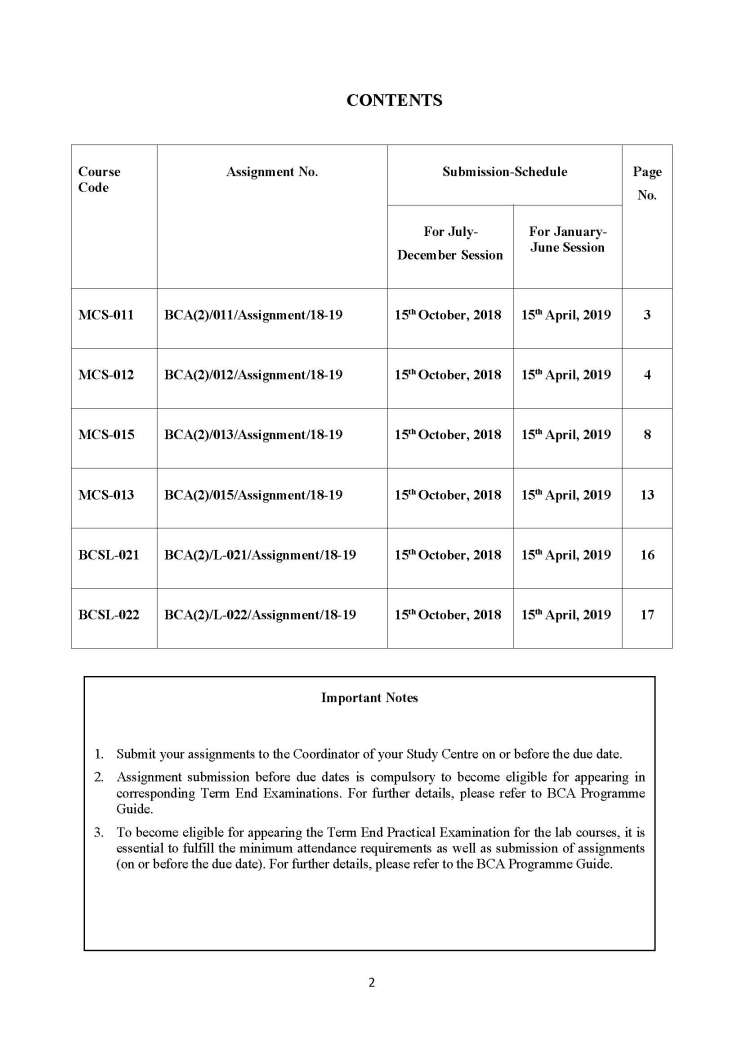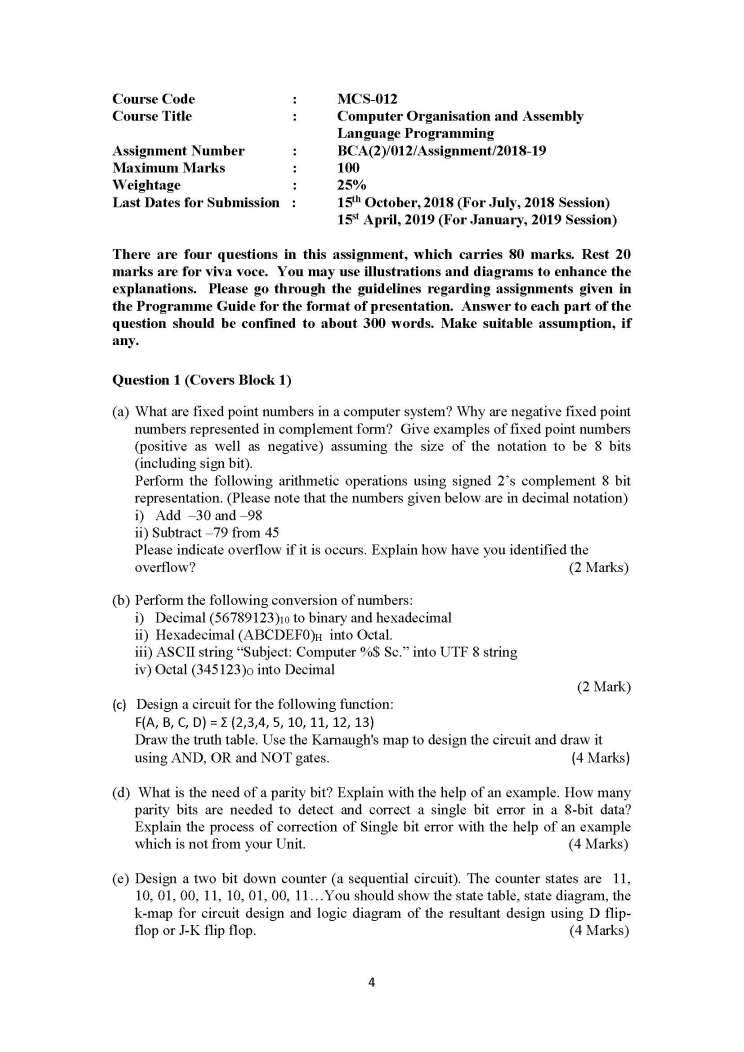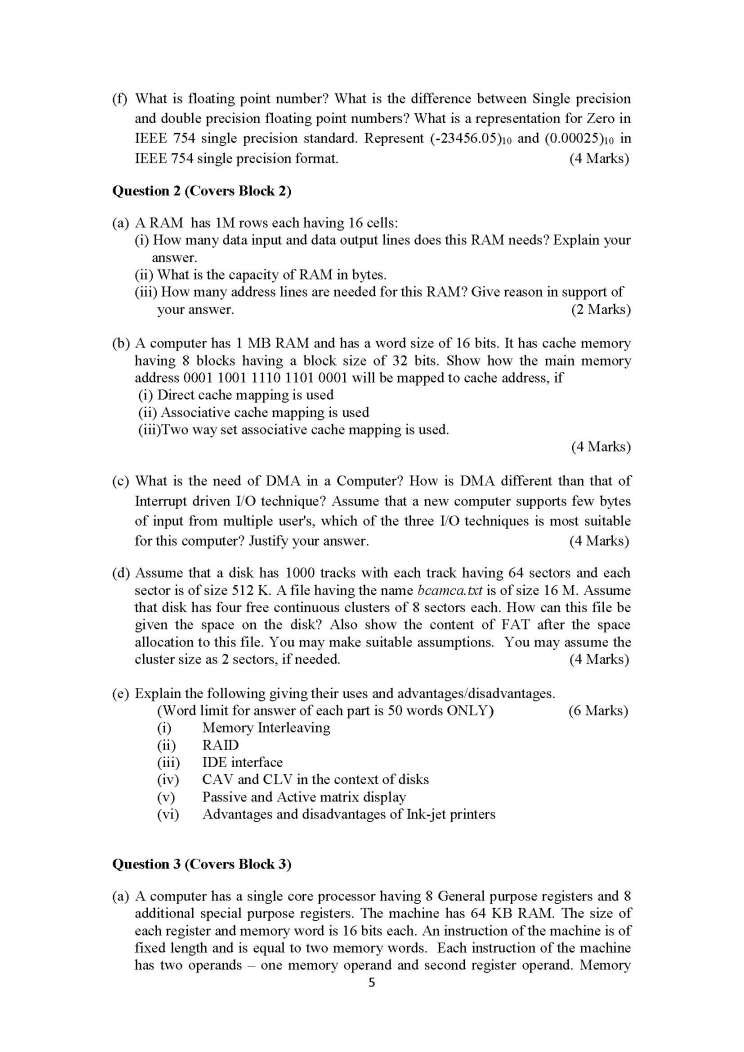|
#1
12th April 2013, 03:52 PM
| |||
| |||
| IGNOU BCA Solved Assignment 2nd SEM
Sir I am a student of IGNOU BCA and I searching for the BCA solved 2nd SEM Assignment so can any one provide me the assignment.
|
|
#2
13th April 2013, 01:32 PM
| |||
| |||
| Re: IGNOU BCA Solved Assignment 2nd SEM
You need the Indira Gandhi National Open University BCA Solved Assignment of 2nd SEM so here I am providing you the solved Assignment I thing it will help you in your studies. Write a program to print the following pattern: a) 1 b) 1 1 2 2 2 1 2 3 3 3 3 1 2 3 4 4 4 4 4 1 2 3 4 5 5 5 5 5 5 Question 2: Declare two arrays A and B, find (i) A intersection B and (ii) A union B. (10 Marks) Question 3: Write a program to crypt its input according to a specified transformation scheme. The transformation scheme will consist of two strings: a string of characters and then a string of replacement characters. The idea is that your program replaces every instance of the ith character in the initial string with the (i+2) character (of English alphabets) in the replacement string. When no substitution is defined for a character, the program just passes it through to the output unchanged. Blank spaces and the other symbols remains the same. The program should inform the user of any errors in the transformation scheme. Your program should display the phrase before and after the substitutions have been made. Example: Original String: I know C programming. String after the transformation: K mpqy E rtqitcookpi. (20 Marks) Question 4: Write an interactive program called “DISTANCE CONVERTER” that accepts the distance in millimetres / feet / miles / yards / kilometres and displays its equivalent in metres. (20 Marks) For the complete assignment I am attaching a pdf File with it .. For any Further assistance kindly contact at the address and phone that is given below:- Contact Details Indira Gandhi National Open University IGNOU Road, Maidangarhi New Delhi, DL 110068 011 2957 1000 Location Map [MAP]https://maps.google.co.in/maps?q=IGNOU&hl=en&ll=28.498415,77.202988&spn=0.04 028,0.077162&oe=utf-8&client=firefox-a&hq=IGNOU&t=m&z=14&iwloc=A[/MAP] Last edited by Shaleen; 13th April 2013 at 01:35 PM. |
|
#3
10th March 2014, 05:42 PM
| |||
| |||
| Re: IGNOU BCA Solved Assignment 2nd SEM
Sir I am a student of IGNOU BCA and I searching for the BCA solved 2nd SEM Assignment so can any one provide me the assignment. Upendra Yadav |
|
#5
28th May 2015, 11:09 AM
| |||
| |||
| Re: IGNOU BCA Solved Assignment 2nd SEM
Please provide me IGNOU (Indira Gandhi National Open University) B.C.A. 2nd Semester Solved Assignment?
|
|
#6
28th May 2015, 11:14 AM
| |||
| |||
| Re: IGNOU BCA Solved Assignment 2nd SEM
Here I am providing you IGNOU (Indira Gandhi National Open University) B.C.A. 2nd Semester Solved Assignment. IGNOU B.C.A. 2nd Semester Solved Assignment: IGNOU B.C.A. 2nd Sem Solved Assignment 1 PROCEDURE CREATE_CD(T) [Where pointer ‘HEAD’ has been caought in pointer ‘T’ and pointer ‘head’ and ‘p’ are global variables] 1. [Allocating the memory for the node and taking value from the user] Call GETNODE (T) DATA (T) <-- ‘xyz’ LEFT (T) <-- S RIGHT (T) <-- 0 RIGHT (S) <-- T S <-- T 2. [Checking the value and calling the function recursively] if (DATA (T) <= 0) RIGHT(LEFT (T)) <-- HEAD LEFT (HEAD) <-- LEFT (T) P <-- LEFT (T) CALL REMOVE NODE (T) return else Call CREATE_CD (T). 3. [FINISH] return. Question 2: What are the advantages of Arrays and Pointers? What is the basis for selection of Arrays or Pointers as data structure in a program. Hint: The main advantages of using pointers are 1.) Function cannot return more than one value. But when the same function can modify many pointer variables and function as if it is returning more than one variable. 2.) In the case of arrays, we can decide the size of the array at runtime by allocating the necessary space. 3.) In the case of pointers to classes, we can use polymorphism and virtual classes to change the behavior of pointers to various types of classes at runtime The main advantages of using array are 1. You can use one name for similar objects and save then with the same name but different indexes. 2. Arrays are very useful when you are working with sequences of the same kind of data (similar to the first point but has a different meaning). 3. Arrays use reference type and so. A pointer can refer to an individual item or to an array of items. In fact, an array is just a way of creating both a list of items and a pointer to that list's first item in one declaration. The array and pointer concepts are more or less completely interchangeable in C. This means that subscripts can be used with pointers, as if they were arrays held at the address of the pointer. As C does no array bound checking, this is completely unsafe. You may assign the address of a simple int variable to a pointer to int and than access locations following it as if they belonged to an array of ints, as follows. void main() { int i, * ip; ip = & i; ip[0] = 3; ip[1] = 2; ip[2] = 1; } On the other hand, an array can be used as if it was a pointer. We have seen that arrays are always passed by reference, even though no & is written, and this is why. The only difference is that the address of an array cannot be changed by assignment. Thus, the following would not be allowed: void main() { int i, ia[]; ia = &i; } Question 3: What is a row major order? What is a column major order? How will you find the location of an element of an array , if the array is stored using row major order? Answer the question, if the array is stored in column major order. Hint: row-major order is a way of mapping the elements of a two-dimensional array onto a vector. If a two-dimensional array, A, with m rows and n columns is mapped in row-major order onto a vector b with mn elements then aij = bk wherek = n(i – 1) + j column-major order is a way of mapping the elements of a two-dimensional array onto a vector, e.g. for representation in memory. If a two-dimensional array, A, with m rows and n columns is mapped in column-major order onto a vector b with m × n elements then aij = bk where k = m(j – 1) + i Find the location of an element of an array, if the array is stored using Row-major order In row-major storage, a multidimensional array in linear memory is accessed such that rows are stored one after the other. It is the approach used by the C programming language as well as many other languages, When using row-major order, the difference between addresses of array cells in increasing rows is larger than addresses of cells in increasing columns. For example, consider this 2×3 array: An array declared in C as int A[2][3] = { {1, 2, 3}, {4, 5, 6} }; would be laid out contiguously in linear memory as: 1 2 3 4 5 6 To traverse this array in the order in which it is laid out in memory, one would use the following nested loop: for (i = 0; i < 2; i++) for (j = 0; j < 3; j++) printf("%d\n", A[i][j]); The difference in offset from one column to the next is 1 and from one row to the next is 3. The linear offset from the beginning of the array to any given element A[row][column] can then be computed as: offset = row*NUMCOLS + column Where NUMCOLS is the number of columns in the array. The above formula only works when using the C convention of labeling the first element 0. In other words, row 1, column 2 in matrix A, would be represented as A[0][1] Note that this technique generalizes, so a 2×2×2 array looks like: int A[2][2][2] = {{{1,2}, {3,4}}, {{5,6}, {7,8}}}; and the array would be laid out in linear memory as: 1 2 3 4 5 6 7 8 Find the location of an element of an array , if the array is stored using Column-major order Column-major order is a similar method of flattening arrays onto linear memory, but the columns are listed in sequence. The programming languages Fortran, use column-major ordering. The array if stored contiguously in linear memory with column-major order would look like the following: 1 4 2 5 3 6 The memory offset could then be computed as: offset = row + column*NUMROWS where NUMROWS represents the number of rows in the array—in this case, 2. Treating a row-major array as a column-major array is the same as transposing it. Because performing a transpose requires data movement, and is quite difficult to do in-place for non-square matrices, such transpositions are rarely performed explicitly. For example, software libraries for linear algebra, such as the BLAS, typically provide options to specify that certain matrices are to be interpreted in transposed order to avoid the necessity of data movement. more detail to attached pdf files |
|
#7
28th November 2019, 09:37 AM
| |||
| |||
| Re: IGNOU BCA Solved Assignment 2nd SEM
Can you provide me the Assignment of Bachelor of Computer Applications (BCA) 2nd Sem offered by School of Computer and Information Sciences of IGNOU (Indira Gandhi National Open University)?
|
|
#8
28th November 2019, 09:39 AM
| |||
| |||
| Re: IGNOU BCA Solved Assignment 2nd SEM
The Assignment of Bachelor of Computer Applications (BCA) 2nd Sem offered by School of Computer and Information Sciences of IGNOU (Indira Gandhi National Open University) is as follows: Question1: Write an algorithm, draw a flow chart and write its corresponding C program to convert a decimal number to its equivalent hexadecimal number. (10 Marks) Question2: Write an algorithm and its corresponding C program to generate students’ Progress-Report for VIII standard (section of 20 students) of a CBSE school for all its 4 terms. Use Structures concept. Assumptions can be made wherever necessary. (10 Marks) Question 3: Write a C program to generate the following pattern: (10 Marks) 1 1 2 1 2 3 1 2 3 4 1 2 3 4 5 Question 4: Write a program to generate Fibonacci series using Recursion. (10 Marks) Question 5: Write a C program to perform the following operation on matrices D = A + (B * C), where A, B and C are matrices of (3 X 3) size and D is the resultant matrix. (10 Marks) Question 6: Write an interactive C program to calculate the string length of a given string, using pointers. (10 Marks) Question 7: Write a C program to take a list of N numbers, separate even and odd numbers and put them in two appropriate files (evenfile and oddfile). Use File Handling concept. (10 Marks) Question 8: Write an interactive C program for each to illustrate the following concepts: (10 Marks) (a)Enumerated data type (b) Macros in C (c) typedef (d) Goto statement (e) Break statement Assignment BCA 2nd Sem IGNOU (Indira Gandhi National Open University)     |